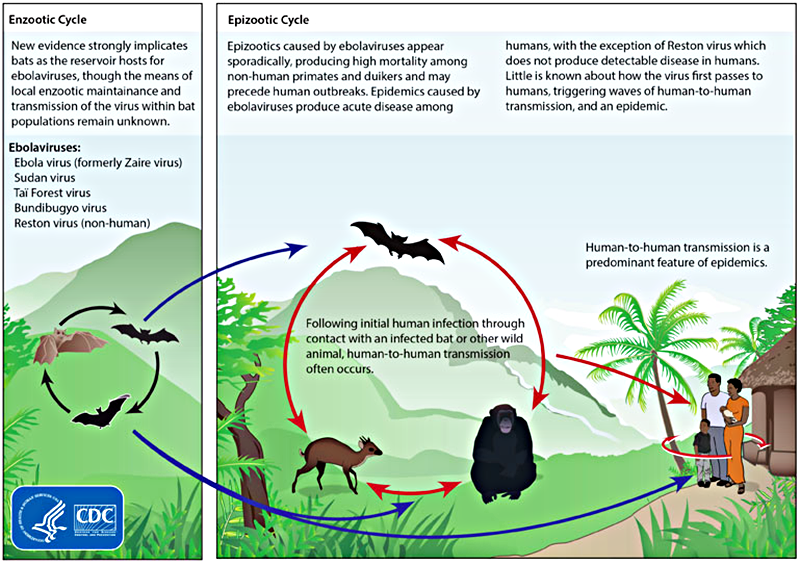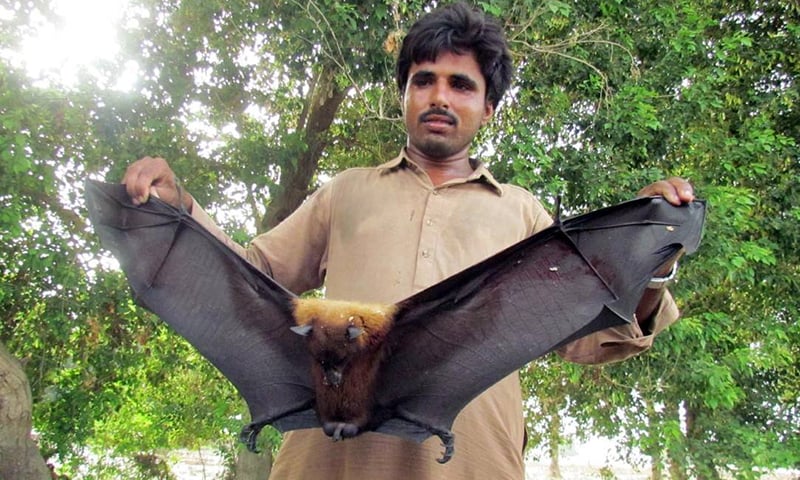This Sunday, as I scanned through the morning papers, I was struck by this large pictorial feature on the Karachi section of Express Tribune. The headline screamed, “Megabats take over fruit trees in rural Sindh”, with the story going on to say that these “scary” and “uninvited guests” with wing spans of more than four feet are “eating up all the mangoes and dates” in the katcha areas of Piryalo.
Scary. Yes. But not as scary as the large picture of a young man proudly posing for the camera while holding one of these megabats.
What he obviously does not know, and what is nowhere mentioned in the story or by Mr Taj Mohammad Shaikh (Sukkur’s deputy conservation of wildlife, who has been quoted in the story), is that the megabats – also called large flying foxes or fruit bats – can sometimes act as reservoirs and vectors for a range of diseases and viruses which are potentially lethal to humans and other animals.
They don't always do that. Most often, if they are carrying a virus, it is not easy for it to be transmitted to humans. But sometimes, they do spread disease; fatal disease, even epidemics. And these are cases that, no matter how infrequent, one should be careful or even worried about.
What diseases can fruit bats cause?
Some recent research, for example, has raised the very scary possibility that fruit bats (possibly the ‘hammer-headed bats’ in southeastern Guinea) may be a natural reservoir for Ebola and may have been the mechanism by which the Zaire strain of Ebola virus was transported some 3,200 kilometres to Ivory Coast in West Africa.
That might have been so because the fruit bats (suborder: Megachiroptera; family: Pteropodidae) seem to be able to carry a number of zoonotic virus strains without themselves showing any signs of infection.
 |
| Life cycles of the Ebolavirus. —Wiki Commons |
One should, of course, be careful in extrapolating too much, since Ebola has been linked to African variants of the megabats. Although these flying foxes are known to migrate over very long distances (in the 1,000 kilometre range), our immediate concern should be about diseases associated with Asian variants of the megabats. These can be equally frightening.
For example, the genus Pteropus (which, unfortunately, is the one known usually found in South Asia, including Pakistan) is known to be a carrier and reservoir of Hendra and Nipah henipaviruses. These are scary things. They are fatal in humans, as well as other mammals.
Infection starts as fever, headaches and drowsiness, with influenza-like symptoms, and can cause severe and often lethal respiratory illness and encephalitis; in some cases, inflammation of the brain leads to disorientation or coma, and around half the cases end in death.
Nipah is the virus that inspired for the 2011 medical horror film, Contagion. These viruses have broken out in recent years in Australia, Malaysia, Singapore, India and Bangladesh. In Bangladesh an outbreak of Nipah, linked to the megabats, infected over 200 people and killed around 60 in 2004-5.
Other, even more scary viruses that we suspect could be carried by the megabats include SARS and Marburg. There are no known cures for any of these.
The need for vigilant action
Enough about the scare. The fact of the matter is, we do not know if the megabats in Piryalo carry any of these – or, for that matter, any – viruses. Fruit bats are native to our region, and from the report, not unknown to those who live in the area.
The first and very urgent goal should be to find out more. Experts in public health and wildlife conservation should be assessing the situation and inspecting the species that has descended on Piryalo, not a local farmer posing for the camera with a dead megabat.
Here is what we do know:
We know that these megabats can migrate over very long distances. They can appear suddenly and in large numbers (in the hundreds). That is what is being reported in Piryalo. We also know that often, those numbers are precursors to even larger numbers of megabats descending on a region (in the tens of thousands). That seems to have not happened yet.
We know from the pictures from Piryalo that it is, in fact, Megachiroptera – megabats or flying foxes – that we are talking about. These are an ancient species (which probably explains why they carry such deadly viruses without being affected themselves).
Some have wondered whether they should be seen as ‘bats’ or ‘primates’, because their faces resemble that of a small dog, and typically they do not echo-locate, but use their large eyes and a sense of smell to find the fruit they so like to eat.
In case it is the ‘Indian Flying Fox’ ...
We do not know this for sure, but it is highly likely that the pictures from Piryalo are of the ‘Indian Flying Fox’ or Pteropus giganteus; a species found all over South Asia; from Bangladesh and beyond to India, Nepal and Sri Lanka, and across Sindh and the Punjab in Pakistan. Like the ones reported in Sindh, this species is frugivorious (eats fruits) and, like most Pakistanis, is especially fond of mangoes.
If, indeed, it is the Indian Flying Fox, then there are three things we should know: (a) they are not an endangered or threatened species; (b) they could soon be roaming across other parts of Sindh and the Punjab; (c) unfortunately, they are a known natural reservoir of disease including Hendra virus and Neipah virus and possibly of coronaviruses that have sometimes been linked to SARS.
All of these are serious causes of concern.
The bats are doing just what they're known to after arriving and settling into a region: Farmers and fruit growers complain that their crops are being destroyed. The smell, the noise and the parasites that come with them beceome unbearable. We also know that this nuisance can quickly grow unbearable and possibly escalate to disease (often via another animal).
That is what happened in the small rural outpost of Gayndah in Queensland, Australia, in 2011.
What began as less than a hundred megabats showing up, soon grew to more than 100,000 who were “defecating on Gayndah from the sky, stripping the trees and urinating into the town’s water supply.” Soon, there was the spectre of disease looming over the town.
At the same time, Gayndah also reminds us that megabats have significant ecological benefits, which include better pollinating and propagating the very fruit trees that they first destroy.
It is just proximity to these megabats that causes concern for humans, in terms of both human health and species conservation. The best solution is often to find ways to move the megabat colonies away from human habitation.
While we shouldn't panic, we must certainly take immediate action.
Someone needs to spread the word in the local communities on what to do, and what not to do – handling dead megabats would be an obvious “not to do.”
Someone needs to contact the appropriate experts, to help determine whether this is benign or potentially worrisome, to help figure out what can or should be done.
This is what local government should be doing, if there were a local government. This is a matter of public health, of wildlife conservation, and, yes, of education. There is too much that we do not know, which we should try to find out. But there is also enough that we do know.














































